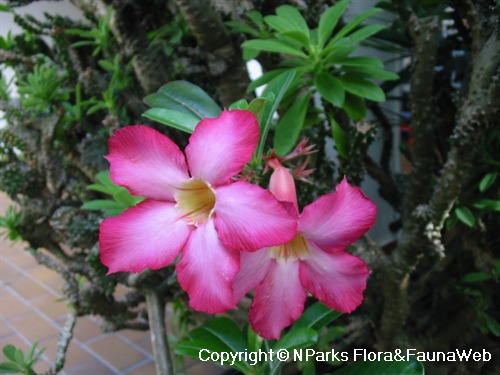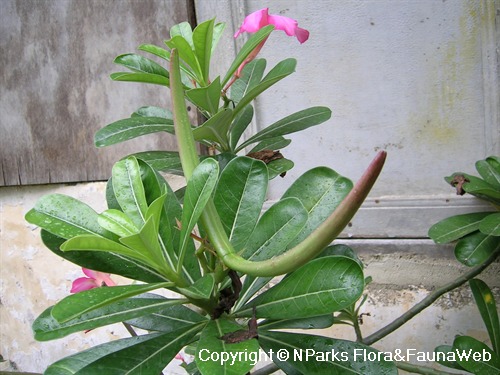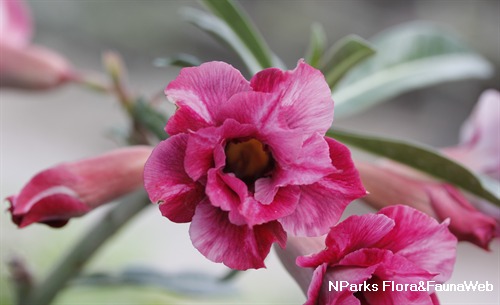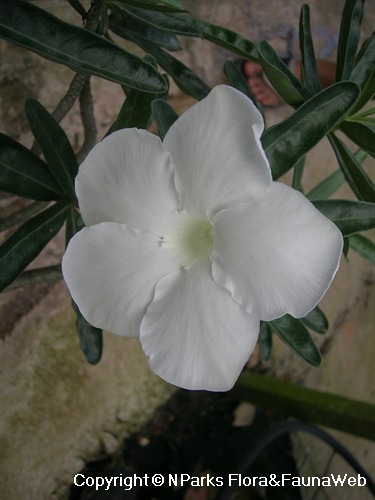
Back
Adenium obesum (Forssk.) Roem. & Schult
| Family Name: | Apocynaceae |
| Synonyms: | Adenium multiflorum, Adenium arabicum |
| Common Name: | Desert Rose, Impala Lily, 沙漠玫瑰, 富贵花 |
Name
Classifications and Characteristics
| Plant Division | Angiosperms (Flowering Seed Plants) (Dicotyledon) |
|---|---|
| Plant Growth Form | Herbaceous Plant |
| Lifespan (in Singapore) | Perennial |
| Mode of Nutrition | Autotrophic |
| Maximum Height | 0.5 m to 2 m |
Biogeography
| Native Distribution | Eastern Africa to Southern Arabia |
|---|
Description and Ethnobotany
| Growth Form | Succulent shrub with a swollen base known as a caudex. |
|---|---|
| Foliage | Smooth, glossy green leaves are obovate with entire leaf margin and truncate or rounded leaf apex. Leaves are spirally arranged. |
| Flowers | Flowers are tubular with 5 oval-shaped lobes that are flared and perpendicular to the floral tube axis (known as salverform). |
| Cultivation | Although this species is commonly known as 'Desert Rose', it grows well in tropical, humid climates. Insects are generally not a problem, but be careful of scale insects, mealy bugs and spider mites. Fungal and bacterial stem or root rot cause serious damage that is difficult to treat. Infected plant parts should be removed immediately. To obtain a plant with a swollen base (caudex), the plant needs to be propagated from seed and not by stem cutting. |
| Ethnobotanical Uses | Others: In Africa, tribal peoples apply the toxic milky latex of this species to arrows. |
Landscaping Features
| Desirable Plant Features | Ornamental Flowers, Ornamental Stems |
|---|---|
| Landscape Uses | Suitable for Bonsai, Container Planting, General |
| Thematic Landscaping | Rockery / Desert Garden |
| Usage Hazard - Cons | Toxic Upon Ingestion |
| Usage Hazard - Cons Remarks | Milky sap is poisonous and can cause skin irritation or allergies. |
Fauna, Pollination and Dispersal
| Seed or Spore Dispersal | Abiotic (Explosive Dehiscence) |
|---|
Plant Care and Propagation
| Light Preference | Full Sun |
|---|---|
| Water Preference | Little Water |
| Plant Growth Rate | Slow |
| Rootzone Tolerance | Easy to Grow, Drought Tolerant |
| Fertilizing | Apply fortnightly or once monthly with water-soluble fertilizer at half-strength. |
| Propagation Method | Seed, Stem Cutting, Air-Layering |
| Maintenance Requirements Remarks | Prune new shoots by removing smallest two leaves at tip of shoot or remove one inch from tip of stem to encourage multi-branching. |
Foliar
| Mature Foliage Colour(s) | Green |
|---|---|
| Mature Foliage Texture(s) | Glossy / Shiny, Leathery |
| Foliar Type | Simple / Unifoliate |
| Foliar Arrangement Along Stem | Spiral |
| Foliar Attachment to Stem | Sessile |
| Foliar Shape(s) | Non-Palm Foliage (Obovate) |
| Foliar Venation | Pinnate / Net |
| Foliar Margin | Entire |
| Foliar Apex - Tip | Rounded, Truncate |
| Foliar Base | Cuneate |
| Leaf Area Index (LAI) for Green Plot Ratio | 4.5 (Shrub & Groundcover - Dicot) |
| Foliage Retention Remarks | In its native habitat, it sheds it leaves during the dry, cool winter. In Singapore, this species is evergreen. |
Non - Foliar and Storage
| Specialised Storage Organ(s) | Aboveground (Caudiciform (Basal Caudex)) |
|---|
Floral (Angiosperm)
| Flower & Plant Sexuality | Bisexual Flowers |
| Flower Colour(s) | Pink |
|---|---|
| Flower Grouping | Cluster / Inflorescence |
| Flower Location | Terminal |
| Flower Symmetry | Radial |
| Individual Flower Shape | Salverform |
| Inflorescence Type | Corymb |
| Flower Lifespan on Plant | Several Weeks |
| Flowering Habit | Polycarpic |
Fruit, Seed and Spore
| Mature Fruit Colour(s) | Green |
|---|---|
| Fruit Classification | Simple Fruit |
| Fruit Type | Dehiscent Dry Fruit , Follicle |
Image Repository
Others
| Master ID | 300 |
|---|---|
| Species ID | 1596 |
| Flora Disclaimer | The information in this website has been compiled from reliable sources, such as reference works on medicinal plants. It is not a substitute for medical advice or treatment and NParks does not purport to provide any medical advice. Readers should always consult his/her physician before using or consuming a plant for medicinal purposes. |



